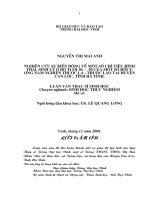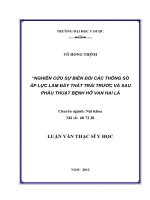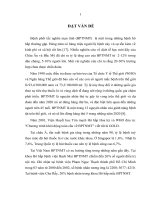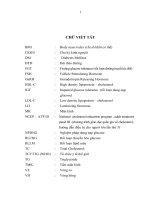NGHIÊN cứu sự BIẾN đổi các THÔNG số TRẮC NGHIỆM GẮNG sức THẢM lăn ở BỆNH NHÂN TRÊN 40 TUỔI mắc hội CHỨNG CHUYỂN HOÁ tại BỆNH VIỆN đa KHOA VĨNH LONG
Bạn đang xem bản rút gọn của tài liệu. Xem và tải ngay bản đầy đủ của tài liệu tại đây (15.39 MB, 7 trang )
Huỳnh Kim Phương
Bnh vi
[16
.
2.1.1.Tiêu chuẩn chọn đối tượng: chia làm 2 nhóm:
-
-
2.1.2. Tiêu chuẩn loại khỏi nghiên cứu:
-
và
-
-
-
khoa
-
PAP, HDL--
-C máu.
-
-6 ngày
2.2.3. Xử lý và phân tích số liệu:
tính SPSS 15.0 for windows, excel 2007.
(n = 60)
(n= 20)
p
n (%)
n (%)
60 (100%)
0 (0%)
<0,01
47 (78,3%)
6 (30%)
<0,01
16 (26,7%)
0 (0%)
<0,01
58 (96,7%)
20 (100%)
>0,05
-C
17 (28,3%)
3 (15%)
>0,05
38 (63,3 %)
16 (80%)
>0,05
96,7%).
(n=60)
(n=20)
p
n (%)
n (%)
<3
41 (68,4%)
0 (0%)
<0,01
>3
19 (31,6%)
20 (100%)
METs (m/phút)
<6
9 (15%)
0 (0%)
<0,05
>6
51 (85%)
20 (100%)
TSK
út)
20000-25000
7 (11, 7%)
2 (10%)
>0,05
25001-30000
35 (58,3%)
8 (40%)
>30000
18 (30%)
10 (50%)
%TST
85-100
51 (85%)
13 (65%)
>0,05
>100
9 (15%)
7 (35%)
( phút)
<6
9 (15%)
0 (0%)
<0,01
6-10
44 (73,3%)
5 (25%)
>10
7 (11,7%)
15 (75%)
p
P (mm)
1,2 ±0,34
1,4 ±0,48
>0,05
Trong GS
1,8 ±0,47
2,4 ±0,88
<0,01
Sau GS
1,6±0,57
2,2 ±0,84
<0,01
R (mm)
13,3±0,43
13,9 ±4,52
>0,05
Trong GS
14,7±4,42
14,9±5,28
>0,05
Sau GS
13,7 ±4,67
14,7 ±3,68
>0,05
QRS (mm)
19,9±6,09
21,1±6,86
>0,05
Trong GS
23,2±5,33
22,3 ±5,8
>0,05
Sau GS
21,1±5,27
22,1 ±5,88
>0,05
T (mm)
2,9 ±1,74
3,5±1,63
>0,05
Trong GS
3,3±1,49
3,9±2,65
>0,05
Sau GS
4,4±2,12
4,9±2,21
>0,05
HCCH
%TST
MET
TSK
-0,125
-0,485**
-0,066
-0,503**
HATT
0,034
-0,293*
0,277*
-0,334**
HATTr
0,040
-0,189
0,234*
-0,192*
Triglycerid
-0,077
-0,045
-0,144
-0,012
HDL-C
0,133
0,401**
0,017
0,416**
Glucose máu
-0,284*
-0,027
-0,236*
-0,053
-
0,05).
< 0,01.
-C
-C,
-0,513**
-0,233*
HATT
-0,333**
-0,202
HATTr
-0,211
-0,067
Triglycerid
-0,140
-0,154
HDL-C
0,281*
0,125
-0,131
0,040
-
NPGS (+)
NPGS (-)
p
n %
n %
10 (100%)
50 (100%)
>0,05
10 (100%)
43 (86%)
>0,05
9 (90%)
38 (76%)
>0,05
10 (100%)
48 (96%)
>0,05
-C
1(10%)
8(16%)
>0,05
6(60%)
32 (64%)
>0,05
NPGS (+)
NPGS (-)
p
n (%)
n (%)
3
2 (8,3%)
22 (91,7%)
24
<0,01
4
6 (21,3%)
22 (78,6%)
28
<0,01
5
2 (25%)
6 (75 %)
8
<0,01
hác
phút,
-
-
-
- HDL-
1.
9(1), tr. 23-30.
2.
, 7A, 7B, tr.35-70.
3.
4. -39.
5. Nguyễn Hữu Trâm Em (1999), Sử dụng nghiệm pháp gắng sức trong đánh giá bệnh tim
mạch, Thi s tim mch hc, 4 (5): tr.241-246.
6.
7.
57.
8.
9.
-2010 468.
10.
-16, 577-587.
11. i (2002),
12. Huỳnh Văn Minh, Nguyễn Văn Điền và Hoàng Anh Tiến (2009), t n sinh
n ch, NXB Đại học Huế, tr.13, 72, 129, 462-466, 660.
13.
t Nam- 44.
14. ,
15.
16.
17.
18.
19. - 96.
20. ACC/AHA (1997), ACC/AHA Guidelines for Exercise Testing:
Exercutive summary A Report of the American College of Cardiology/ American
Association Task Force on Practice Guideline
21. Bernard Ch. (1997), Exercise Stress Testing, Heart Disease, Edited by Braunwald W.B.
Saunders Company 7th edition , vol 1, pp.153-176.
22. Davey P. et al. (1999), Heart Rate and catecholamine Contribution to QT Interval
Sorterning on Exercise, Clin-Cardiol, 22(8), pp.513-518.
23. Domanski M and Proschan M (2004). The metabolic syndrome, J. Am. Coll.Cardiol;
43(8), pp.1396-1398.
24. Edward K. C. (1983), Exercise Electrocardiography, 2nd Edition, Williams & Wilkins.
25. Fletcher G. F. et al. (2001), Exercise Standards for Testing and Training. A Statement for
Healthcare Professionals From the American Heart Association, Circulation 104:1694-
1785.
26. Fletcher G.F. et al. (1996), Statement on Exercise. Benefits and Recommendations for
Physical Activity Programs for All Americans, Circulation, 94, pp. 857-862.
27. Froelicher F. V. and Susan Q. (1996), Handbook of Exercise Testing, Little, Brown and
Company, Boston - New York-Toronto-London, pp. 53, 95, 107 - 112.
28. Haffner S, Cassells HB (2003), Metabolic syndrome - a new risk factor of coronary heat
disease?, Diabetes Obes metab, (5), pp 359 - 370.
29. Heart disease and Stroke statistics (2006), A report from the Amerrican Heart
Association Statistics Committee and Stroke Statistics Subcommittee, 113(6), pp.85- 151.
30. Hiroyasu Iso, (2007), Metabolic syndrome and the risk of ischemic heart disease nad
stroke among Japanese Men and Women, Stroke, 38, pp.1744-1751.
31. International Diabetes Federation (2005), The IDF consensus worldwide definition of the
metabolic syndrome.
32. Jidong S. et al. (2006), Metabolic Syndrome Is Associated with Delayed Heart Rate
Recovery after Exercise, J Korean Med Sci, 21, pp.621- 626.
33. Spies C, et al, (2005), Association of metabolic syndrome with exercise capacity and
heart rate recovery in patients with coronary heart disease in the heart and soul study, Am
J Cardiol, 15,95(10):1175-1179.









